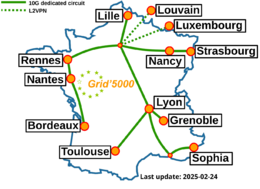Grid5000:Home
|
Grid'5000 is a precursor infrastructure of SLICES-RI, Scientific Large Scale Infrastructure for Computing/Communication Experimental Studies.
|
|
Grid'5000 is a large-scale and flexible testbed for experiment-driven research in all areas of computer science, with a focus on parallel and distributed computing, including Cloud, HPC, Big Data and AI. Key features:
Older documents:
|
Random pick of publications
Five random publications that benefited from Grid'5000 (at least 2899 overall):
- Houssam Elbouanani, Chadi Barakat, Walid Dabbous, Thierry Turletti. Fidelity-aware Large-scale Distributed Network Emulation. Computer Networks, 2024, 10.1016/j.comnet.2024.110531. hal-04591699 view on HAL pdf
- Romaric Pegdwende Nikiema, Marcello Traiola, Angeliki Kritikakou. Impact of Compiler Optimizations on the Reliability of a RISC-V-based Core. DFT 2024 - 37th IEEE International Symposium on Defect and Fault Tolerance in VLSI and Nanotechnology Systems, Oct 2024, Oxfordshire, United Kingdom. pp.1-1. hal-04731794 view on HAL pdf
- François Lemaire, Louis Roussel. Parameter Estimation using Integral Equations. Maple Transactions, 2024, Proceedings of the Maple Conference 2023, 4 (1), 10.5206/mt.v4i1.17126. hal-04560846v2 view on HAL pdf
- Mathieu Bacou. FaaSLoad : fine-grained performance and resource measurement for function-as-a-service. 2024. hal-04836444 view on HAL pdf
- Mateusz Gienieczko, Filip Murlak, Charles Paperman. Supporting Descendants in SIMD-Accelerated JSONPath. International Conference on Architectural Support for Programming Languages and Operating Systems (ASPLOS 2024), 2024, San Diego (California), United States. pp.338-361, 10.4230/LIPIcs. hal-04398350 view on HAL pdf
Latest news
![]() Cluster "larochette" is now in the default queue in Luxembourg
Cluster "larochette" is now in the default queue in Luxembourg
We are pleased to announce that the larochette[1] cluster of Luxembourg is now available in the default queue.
Larochette is a cluster composed of 7 nodes, each with 4 MI210 AMD GPUs.
The node features:
This cluster was funded by the University of Luxembourg.
[1] https://www.grid5000.fr/w/Luxembourg:Hardware#larochette
-- Grid'5000 Team 17:46, 26 August 2025 (CEST)
The first SLICES-FR School is organized from July 7th to 11th in Lyon.
This free event, co-organized with the PEPR Cloud and Networks of the Future, brings together researchers, engineers and professionals to explore advances in distributed computing, edge computing, reprogrammable networks and the IoT.
-- Grid'5000 Team 09:30, 9 July 2025 (CEST)
![]() Cluster "vianden" is now in the default queue in Luxembourg
Cluster "vianden" is now in the default queue in Luxembourg
We are pleased to announce that the vianden[1] cluster of Luxembourg is now available in the default queue.
Vianden is a cluster of a single node with 8 MI300X AMD GPUs.
The node features:
The AMD MI300X GPUs are not supported by Grid'5000 default system (Debian 11). However, one can easily unlock full GPU functionality by deploying the ubuntu2404-rocm environment:
fluxembourg$ oarsub -t exotic -t deploy -p vianden -I
fluxembourg$ kadeploy3 -m vianden-1 ubuntu2404-rocm
More information in the Exotic page.
This cluster was funded by the University of Luxembourg.
[1] https://www.grid5000.fr/w/Luxembourg:Hardware#vianden
-- Grid'5000 Team 11:30, 27 June 2025 (CEST)
![]() Cluster "hydra" is now in the default queue in Lyon
Cluster "hydra" is now in the default queue in Lyon
We are pleased to announce that the hydra[1] cluster of Lyon is now available in the default queue.
As a reminder, Hydra is a cluster composed of 4 NVIDIA Grace-Hopper servers[2].
Each node features:
Due to its bleeding-edge hardware, the usual Grid'5000 environments are not supported by default for this cluster.
(Hydra requires system environments featuring a Linux kernel >= 6.6). The default system on the hydra nodes is based on Debian 11, but **does not provide functional GPUs**. However, users may deploy the ubuntugh2404-arm64-big environment, which is similar to the official Nvidia image provided for this machine and provides GPU support.
To submit a job on this cluster, the following command may be used:
oarsub -t exotic -p hydra
This cluster is funded by INRIA and by Laboratoire de l'Informatique du Parallélisme with ENS Lyon support.
[1] Hydra is the largest of the modern constellations according to Wikipedia: https://en.wikipedia.org/wiki/Hydra_(constellation)
[2] https://developer.nvidia.com/blog/nvidia-grace-hopper-superchip-architecture-in-depth/
-- Grid'5000 Team 16:42, 12 June 2025 (CEST)
Grid'5000 sites
Current funding
INRIA |
CNRS |
UniversitiesIMT Atlantique |
Regional councilsAquitaine |




